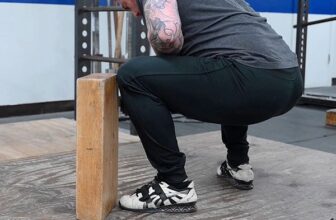
Strength training is the
use of exercises to incrementally and progressively increase
force production capacity for physical performance. It is most
effectively accomplished with barbell training using basic human
movement patterns under load – something that the barbell does
better than any other exercise “modality” (a term beloved of
academic types). You stand on the floor and produce force with your
whole body against an external resistance while not falling down,
which should seem familiar to you if you’re actually alive. Barbell
training is the best way to strengthen normal human movement
patterns: squatting down and standing back up, picking something up
from the ground, pushing something overhead, pushing something
forward away from you, pulling something toward you, and throwing
something.
Squats with the bar on
your back, deadlifts, presses, bench presses (balanced on your back
instead of your feet), chins or barbell rows, and power cleans are
the primary strength training exercises, and these can be loaded
progressively for years. And at first nothing else is necessary: the
first year or so of strength training is more productively composed
of nothing but the
basic exercises.
Assistance exercises are,
basically, everything else. Starting Strength:
Basic Barbell Training 3rd edition
defines Assistance Exercises as 1). portions of the basic exercises,
like halting deadlifts or rack pulls, 2). variations of the basic
movements, such as stiff-legged deadlifts or pause squats, or 3).
ancillary
exercises that work a portion of the muscle mass involved in a basic
exercise, but in a way the basic exercise does not, like a lying
triceps extension. Less-useful – and completely optional –
assistance exercises are unilateral
exercises, single-joint exercises, dumbbell exercises, cable
exercises, ab exercises, calf exercises, flyes, pec decks, wrist
curls, leg curls, and anything done on a machine.
When Starting
Strength was first written in 2005, I hadn’t
considered that strength training could be defined as the normal
bi-lateral human movement patterns subjected to an incrementally
progressive load. This means chin-ups and barbell rows are strength
training movements, not assistance exercises. We use chins very early
in the program, after the first few weeks, and they progress
incrementally for sets to failure as the trainee gains weight. They
can also be loaded for sets of 5 with plates on a dip belt.
And a case can be made for
the use of the barbell row after the first few months have
strengthened the deadlift to the point that a flat back can be
maintained off the floor with useful weight on the bar.
But the critical question
is simply, what is the purpose of assistance exercises? Are they
necessary, and if so, when? Ask yourself this question: have your
squats ever gone up because you did your leg extensions? Obviously
not, but they may well have improved when you added paused box squats
to your programming. And if you added leg extensions and your squat
was going up anyway, and they continued to go up, can you say that
they helped? Squats go up because you add 5 more pounds and squat it
for 5 reps, not because you pick a favorite muscle group to “catch
a pump.”
Your deadlift never went
up because you did weighted glute/ham raises, but rack pulls and
haltings can put another 100 pounds on your third attempt over the course of two years. In fact, if you can’t do a
bodyweight chin-up now, try it again after your deadlift is over 365.
Heavy deadlifts and deadlift-like exercises make your deadlift go up
– 5 pounds at a time. Dumbbell flyes never made anyone’s bench go
up, but overload partials in the rack do, when you add 5 more pounds.
So it matters which assistance exercises you do, and how you do them.
But it also matters when
you add them to your training. A 3-month baby novice has no business
doing anything but the basic exercises until he can no longer make
incremental increases every workout, or even every week. Once your
deadlift is in the 500s, the first assistance exercises to add would
be haltings and rack pulls, possibly replacing deadlifts for most
heavy pulling work. But not before – novices are wasting time doing
anything other than the basic lifts as long as they are progressing
incrementally.
And here’s the most
critical question: if they’re not necessary, why does everybody do
them anyway? And the answer is the same as answering the question,
“Why did everybody wear the mask when they don’t do a single useful
goddamn thing?”
Ready? Because you’re
supposed to. It’s
always been done, and that’s what we do, so there’s no need to
confuse yourself with factual analysis – just do what your supposed
to do so we can go home.
“Supposed to” is an
English idiom that means “what you should
do” or “what you are expected
to do.” Yes, you are supposed to do your leg extensions and your
dumbbell flyes when you train, because we paid a lot of money for
this equipment and you should use it. See this poster? But the actual
fact is that it doesn’t
make you stronger, it cannot
make you stronger, but that it nonetheless adds unnecessary stress
that has to be recovered from even though it does not improve force
production capacity.
Better you than us, right?
There are a lot of baseless assumptions encumbering the Fitness
Industry that legitimate strength training should disabuse itself of.
Higher reps for “hypertrophy” is an excellent example: it is
possible to go from a skinny 165-pound kid to a useful 225-pound man
without doing a single set of high-rep anythings. We do it all the
time, because muscle growth
is the primary mechanism for an increase in force production, and
calling it “hypertrophy” doesn’t change the physiology. Nothing
stresses force production capacity over time better than sets of 5
reps, so that’s what makes you get bigger most efficiently. Sets of
10 are light weights, and light weights don’t make you need to get
bigger – heavy sets of 5 do.
Unnecessary ineffective
assistance exercises are an example of this same faulty reasoning.
Simply waving things around in the air accomplishes nothing more than
burning a few calories. Recovery capacity is finite, and the best way
to shut down progress is to include a bunch of useless shit in your
workouts. All the components of your training program should be there
for a reason, they should be carefully evaluated for the purpose of
increasing your force production capacity, and if they don’t
accomplish this purpose they should be either eliminated or replaced
with something that does.
Credit : Source Post






